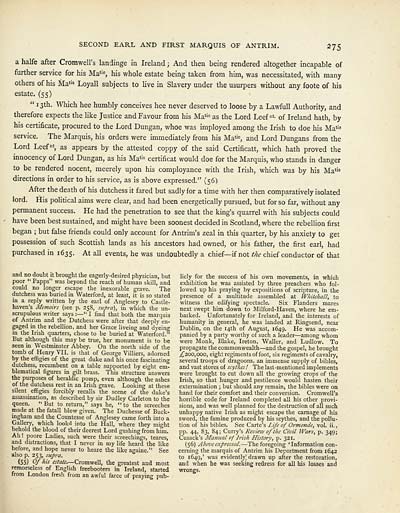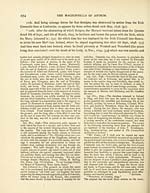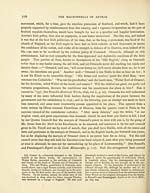Historical account of the Macdonnells of Antrim
(289) Page 275
Download files
Complete book:
Individual page:
Thumbnail gallery: Grid view | List view

SECOND EARL AND FIRST MARQUIS OF ANTRIM.
275
a halfe after Cromwell's landinge in Ireland ; And then being rendered altogether incapable of
further service for his Ma tie , his whole estate being taken from him, was necessitated, with many
others of his Ma tis Loyall subjects to live in Slavery under the usurpers without any foote of his
estate. (55)
" 13th. Which hee humbly conceives hee never deserved to loose by a Lawfull Authority, and
therefore expects the like Justice and Favour from his Ma tie as the Lord Leef nt - of Ireland hath, by
his certificate, procured to the Lord Dungan, whoe was imployed among the Irish to doe his Ma tis
service. The Marquis, his orders were immediately from his Ma tie , and Lord Dungans from the
Lord Leef nt , as appears by the attested coppy of the said Certificatt, which hath proved the
innocency of Lord Dungan, as his Ma tis certificat would doe for the Marquis, who stands in danger
to be rendered nocent, meerely upon his comployance with the Irish, which was by his Ma' is
directions in order to his service, as is above expressed." (56)
After the death of his dutchessit fared but sadly for a time with her then comparatively isolated
lord. His political aims were clear, and had been energetically pursued, but for so far, without any
permanent success. He had the penetration to see that the king's quarrel with his subjects could
have been best sustained, and might have been soonest decided in Scotland, where the rebellion first
began ; but false friends could only account for Antrim's zeal in this quarter, by his anxiety to get
possession of such Scottish lands as his ancestors had owned, or his father, the first earl, had
purchased in 1635. At all events, he was undoubtedly a chief— if not the chief conductor of that
and no doubt it brought the eagerly-desired physician, but
poor " Papps" was beyond the reach of human skill, and
could no longer escape the inexorable grave. The
dutchess was buried in Waterford, at least, it is so stated
in a reply written by the earl of Anglesey to Castle-
haven's Memoirs (see p. 258, supra), in which the un-
scrupulous writer says :— " I find that both the marquis
of Antrim and the Dutchess were after that deeply en-
gaged in the rebellion, and her Grace liveing and dyeing
in the Irish quarters, chose to be buried at Waterford."
But although this may be true, her monument is to be
seen in Westminster Abbey. On the north side of the
tomb of Henry VII. is that of George Villiers, adorned
by the effigies of the great duke and his once fascinating
dutchess, recumbent on a table supported by eight em-
blematical figures in gilt brass. This structure answers
the purposes of heraldic pomp, even although the ashes
of the dutchess rest in an Irish grave. Looking at these
silent effigies forcibly recalls the scene of the duke's
assassination, as described by sir Dudley Carleton to the
queen. "But to return," says he, "to the screeches
made at the fatall blow given. The Duchesse of Buck-
ingham and the Countesse of Anglesey came forth into a
Gallery, which lookd into the Hall, where they might
behold the blood of their deerest Lord gushing from him.
Ah! poore Ladies, such were their screechings, teares,
and distractions, that I never in my life heard the like
before, and hope never to heare the like againe." See
also p. 253, supra.
(55) Of his estate.— Cromwell, the greatest and most
remorseless of English freebooters in Ireland, started
from London fresh from an awful farce of praying pub-
licly for the success of his own movements, in which
exhibition he was assisted by three preachers who fol-
lowed up his praying by expositions of scripture, in the
presence of a multitude assembled at Whitehall, to
witness the edifying spectacle. Six Flanders mares
next swept him down to Milford-Haven, where he em-
barked. Unfortunately for Ireland, and the interests of
humanity in general, he was landed at Ringsend, near
Dublin, on the 14th of August, 1649. He was accom-
panied by a party worthy of such a leader — among whom
were Monk, Blake, Ireton, Waller, and Ludlow. To
propagate the commonwealth — and the gospel, he brought
,£200,000, eight regiments of foot, six regiments of cavalry,
several troops of dragoons, an immense supply of bibles,
and vast stores of scythes! The last-mentioned implements
were brought to cut down all the growing crops of the
Irish, so that hunger and pestilence would hasten their
extermination ; but should any remain, the bibles were on
hand for their comfort and their conversion. Cromwell's
horrible code for Ireland completed all his other provi-
sions, and was well planned for the destruction of all such
unhappy native Irish as might escape the carnage of his
sword, the famine produced by his scythes, and the pollu-
tion of his bibles. See Carte's Life of Ormonde, vol. ii. ,
pp. 44, 83, 84; Curry's Review of the Civil Wars, p. 349;
Cusacks Manual of Irish History, p. 321.
(56) Above expressed. — The foregoing ' Information con-
cerning the marquis of Antrim his Deportment from 1642
to 1649,' was evidently] drawn up after the restoration,
and when he was seeking redress for all his losses and
wrongs.
275
a halfe after Cromwell's landinge in Ireland ; And then being rendered altogether incapable of
further service for his Ma tie , his whole estate being taken from him, was necessitated, with many
others of his Ma tis Loyall subjects to live in Slavery under the usurpers without any foote of his
estate. (55)
" 13th. Which hee humbly conceives hee never deserved to loose by a Lawfull Authority, and
therefore expects the like Justice and Favour from his Ma tie as the Lord Leef nt - of Ireland hath, by
his certificate, procured to the Lord Dungan, whoe was imployed among the Irish to doe his Ma tis
service. The Marquis, his orders were immediately from his Ma tie , and Lord Dungans from the
Lord Leef nt , as appears by the attested coppy of the said Certificatt, which hath proved the
innocency of Lord Dungan, as his Ma tis certificat would doe for the Marquis, who stands in danger
to be rendered nocent, meerely upon his comployance with the Irish, which was by his Ma' is
directions in order to his service, as is above expressed." (56)
After the death of his dutchessit fared but sadly for a time with her then comparatively isolated
lord. His political aims were clear, and had been energetically pursued, but for so far, without any
permanent success. He had the penetration to see that the king's quarrel with his subjects could
have been best sustained, and might have been soonest decided in Scotland, where the rebellion first
began ; but false friends could only account for Antrim's zeal in this quarter, by his anxiety to get
possession of such Scottish lands as his ancestors had owned, or his father, the first earl, had
purchased in 1635. At all events, he was undoubtedly a chief— if not the chief conductor of that
and no doubt it brought the eagerly-desired physician, but
poor " Papps" was beyond the reach of human skill, and
could no longer escape the inexorable grave. The
dutchess was buried in Waterford, at least, it is so stated
in a reply written by the earl of Anglesey to Castle-
haven's Memoirs (see p. 258, supra), in which the un-
scrupulous writer says :— " I find that both the marquis
of Antrim and the Dutchess were after that deeply en-
gaged in the rebellion, and her Grace liveing and dyeing
in the Irish quarters, chose to be buried at Waterford."
But although this may be true, her monument is to be
seen in Westminster Abbey. On the north side of the
tomb of Henry VII. is that of George Villiers, adorned
by the effigies of the great duke and his once fascinating
dutchess, recumbent on a table supported by eight em-
blematical figures in gilt brass. This structure answers
the purposes of heraldic pomp, even although the ashes
of the dutchess rest in an Irish grave. Looking at these
silent effigies forcibly recalls the scene of the duke's
assassination, as described by sir Dudley Carleton to the
queen. "But to return," says he, "to the screeches
made at the fatall blow given. The Duchesse of Buck-
ingham and the Countesse of Anglesey came forth into a
Gallery, which lookd into the Hall, where they might
behold the blood of their deerest Lord gushing from him.
Ah! poore Ladies, such were their screechings, teares,
and distractions, that I never in my life heard the like
before, and hope never to heare the like againe." See
also p. 253, supra.
(55) Of his estate.— Cromwell, the greatest and most
remorseless of English freebooters in Ireland, started
from London fresh from an awful farce of praying pub-
licly for the success of his own movements, in which
exhibition he was assisted by three preachers who fol-
lowed up his praying by expositions of scripture, in the
presence of a multitude assembled at Whitehall, to
witness the edifying spectacle. Six Flanders mares
next swept him down to Milford-Haven, where he em-
barked. Unfortunately for Ireland, and the interests of
humanity in general, he was landed at Ringsend, near
Dublin, on the 14th of August, 1649. He was accom-
panied by a party worthy of such a leader — among whom
were Monk, Blake, Ireton, Waller, and Ludlow. To
propagate the commonwealth — and the gospel, he brought
,£200,000, eight regiments of foot, six regiments of cavalry,
several troops of dragoons, an immense supply of bibles,
and vast stores of scythes! The last-mentioned implements
were brought to cut down all the growing crops of the
Irish, so that hunger and pestilence would hasten their
extermination ; but should any remain, the bibles were on
hand for their comfort and their conversion. Cromwell's
horrible code for Ireland completed all his other provi-
sions, and was well planned for the destruction of all such
unhappy native Irish as might escape the carnage of his
sword, the famine produced by his scythes, and the pollu-
tion of his bibles. See Carte's Life of Ormonde, vol. ii. ,
pp. 44, 83, 84; Curry's Review of the Civil Wars, p. 349;
Cusacks Manual of Irish History, p. 321.
(56) Above expressed. — The foregoing ' Information con-
cerning the marquis of Antrim his Deportment from 1642
to 1649,' was evidently] drawn up after the restoration,
and when he was seeking redress for all his losses and
wrongs.
Set display mode to:
![]() Universal Viewer |
Universal Viewer | ![]() Mirador |
Large image | Transcription
Mirador |
Large image | Transcription
Images and transcriptions on this page, including medium image downloads, may be used under the Creative Commons Attribution 4.0 International Licence unless otherwise stated. ![]()
| Histories of Scottish families > Historical account of the Macdonnells of Antrim > (289) Page 275 |
|---|
| Permanent URL | https://digital.nls.uk/95344715 |
|---|
| Description | A selection of almost 400 printed items relating to the history of Scottish families, mostly dating from the 19th and early 20th centuries. Includes memoirs, genealogies and clan histories, with a few produced by emigrant families. The earliest family history goes back to AD 916. |
|---|

